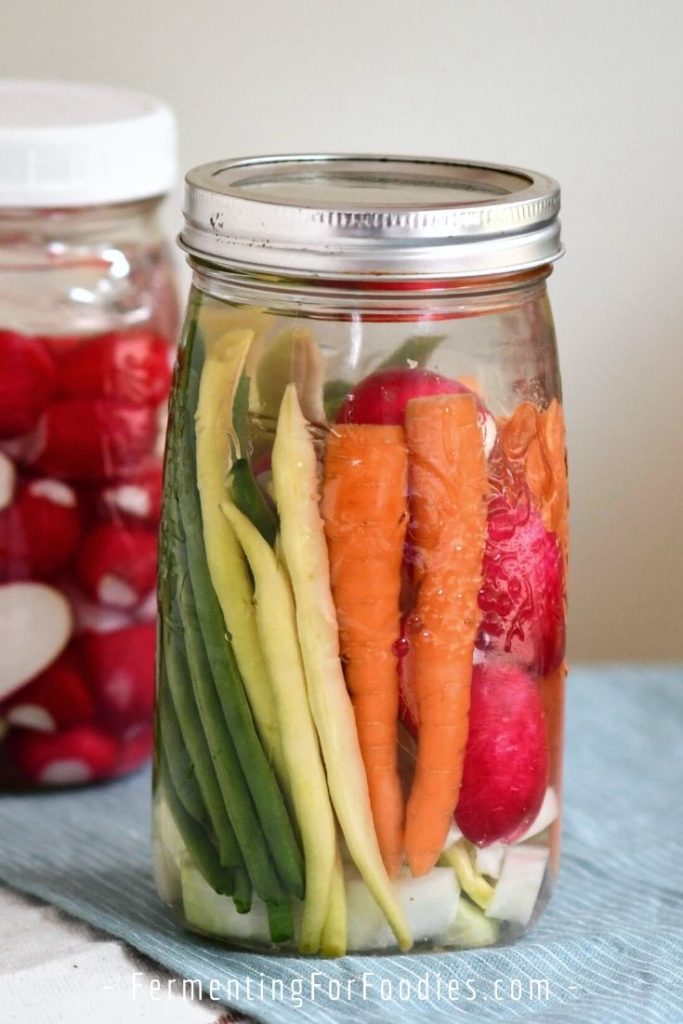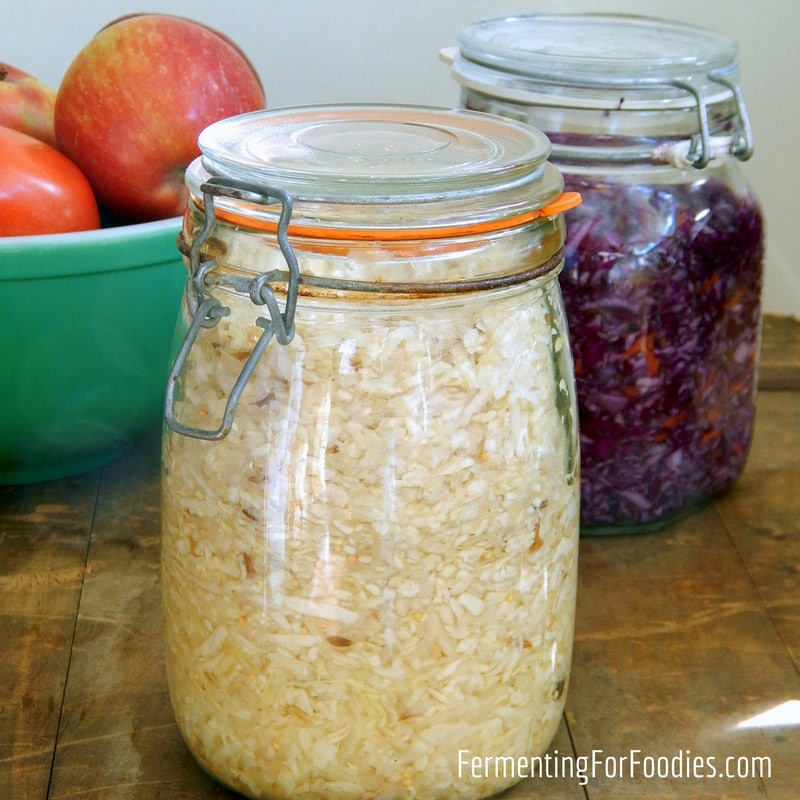Fermenting is a mix of art and science. It takes a bit of know-how, a good culture as well as good conditions. Here are a few common problems that can arise when fermenting.

I’ve been into fermentation since 2014. In that time, I’ve had a few failures. And I would like to assure you that failures are really rare.
Regardless, this post covers a few of the more common problems with fermented foods.
Here are a few posts that go into detail about a particular problem. They may be a good place to start if you’re struggling with a specific problem.
- Kahm yeast and mold
- Why fermentation hasn’t started after 24 hours
- How to solve cheesemaking problems
- Taking care of a sourdough starter
- Common kombucha problems
Too Much Salt
What if you don’t like your fermented vegetables to be so salty, or maybe you’re supposed to avoid salt for health reasons? Are there ways to avoid the salt?
Truthfully, it’s risky to ferment with less salt than is suggested in the recipe. Salt brined ferments need salt to prevent contamination from the wrong type of bacteria, yeast, or mold. However, there are a few ways to decrease salt.
- Rinse some of the salt off before eating the ferment. This works for sauerkraut and quick fermented vegetables. Longer ferments usually are infused with salt.
- Add the vegetables to a soup or stew instead of adding salt. For example, sauerkraut can replace added salt in potato soup.
- If you want to try using a low-salt brine, then make sure all other aspects of your ferment are perfect. Sanitize everything, use a starter culture, ferment at the right temperature, and use an air-lock or fido jar.
- Want more info? Here’s a whole post devoted to low-salt or salt-free sauerkraut.
Over-flowing or bulging jars
Most ferments produce carbon dioxide, which bubble and can cause your ferments to overflow. If you’re fermenting in a sealed jar without an air-lock or other type of gasket, then the jar could even explode!
Here’s how to prevent over-flowing jars:
- Use jars that allow for gas to escape, and leave lots of headroom for things to bubble up.
- If you’re bottling fermented drinks, then use plastic pop bottles or bottles with a swing-top lid that are made for carbonated beverages.
- If all you have is a regular jar or container, then just make sure to open it daily to release the pressure.
Funny smell
Most ferments have a unique smell. This smell can often range from yeasty to egg-like depending on what you are fermenting. (Cauliflower can be quite stinky!)
Just because something smells funny, doesn’t mean that it has gone off. Things that bad usually smell so bad that you would NEVER consider eating them. If your ferment smells rotten, then you have to throw it away.

Change in color
Many vegetables will change their color and texture as they ferment. This is especially true if you’ve added something that is a natural dye (beets, turmeric). However, even plain sauerkraut will change from a bright green to a pale yellow-green.
If something is rotting, then it will look rotten (brown) and smell awful.
I’ve covered a few common problems, but if you’re struggling with something different, feel free to write in the comments below or on the Fermenting for Foodies Facebook page and I’ll try to help you out!


I have been fermenting cabbage for a little over a year. This batch is the first time it looks funny. Water seems to be slimey. Smells fine. Do I have a problem.?
Hum… I’ve never seen slimy water. Are the vegetables slimy? There are a number of bacteria involved in sauerkraut, and it may depend on the exact strains in there right now. Here’s my suggestion: 1. Remove any slimy cabbage (at the top of the jar). 2. Leave it to ferment for another 2 weeks. The most likely contamination is mold and yeast. If you end up with either of those, then you know. If it’s absolutely the wrong type of bacteria, then it will smell off and look bad and you should throw it out. If it seems fine, then you know it isn’t contaminated.
Good luck!
Hello
I jarred giardiniera and habanero paste two days ago and I haven’t seen signs of fermenting. No bubbles. What can I do? Can they be saved or do I just toss them? Thank you for your help.
Hum… if you’re new to fermenting, it can take a little while before your house naturally has enough culture for a good strong ferment. If they haven’t gone off (mold or yeast) then they are still fine to eat. I would stick the giardiniera in the fridge and enjoy it in the next few weeks. Give the hot sauce another 2-3 days, then strain and store. Keep trying! The more you ferment the easier it is because your house will develop a good strong culture.
I have a cultured vegetable question of you have any ideas. I just noticed an interesting whitish layer in my pickles. I’ve read that if they get yeasty you can get a white layer on top, and that you can just scoop it out, but this is at the bottom, just above the spices… Any thoughts?
Don’t worry, that whiteish layer is perfectly normal. It’s the yeast in the fermented dill pickle culture and it’s what is supposed to happen. It means that your pickles are ready to eat! 🙂 –I’m assuming there’s just a hint of whiteness, not a huge amount… like a bit settling around the bottom.–
my beef kvass tastes like salty pickles it’s been fermenting for 1.5 weeks. there are no bubbles either. is it still good?
thank-you and have a good day
Shannon
Beet kvass will stop bubbling after 5 to 7 days. As long as you don’t have any mold, it should be good to drink! Cheers!
Hi Emillie,
I have a jar of fermented brown onion which I just opened after 10 days. I used a 2.5% brine solution. I used a weight and an airlock lid system. No kahm yeast was present in the brine when I opened the jar, no mold either. I though it was a success, but when I tasted the onion it was not sour/ acidic, it wasn’t tasting like pickle onions, it is weird, almost like a soap taste to me. Doesn’t smell bad and doesn’t look rotten. I don’t have a ph meter to read, unfortunately. I have absolute no clue of what possible happened to this ferment. Have you ever came across with something like this? it’s the 4th time I’m trying to ferment onions with no success, I’m getting so unmotivated to try it again. Could you give me a help?
Thank you and kind regards, Liz
Hum… it sounds like you have a pretty good grasp of fermenting. I don’t think a pH meter is necessary (and often they are unreliable). I have a few ideas. 1. It may be the culture on the onion. While we want Lactic bacteria, sometimes there are other strains that aren’t harmful, but aren’t ideal. (Two common ones are kahm yeast and a bacteria that makes brine become thick and gel-like). 2. Maybe there just isn’t any culture on the onions. So while they aren’t going bad, they also aren’t fermenting.
Either way, maybe try using a starter culture? This could either be a bit of sauerkraut brine, raw ACV, or unflavored kombucha. If you don’t have any of those handy, just add a wedge of cabbage in your jar. Cabbage has such a good reliable culture that it might kick-start the whole process.
It’s always hard to diagnoses problems like this… so hopefully my advice is helpful! Cheers, Emillie
Should my brine be cloudy?
Brine is often cloudy, especially if you’re fermenting it for several weeks. For example, my fermented pickles always are a bit cloudy as the yeast dies off. Eventually, the dead yeast settles in the jar, so you may see a whitish powder setting on the vegetables. Cheers!